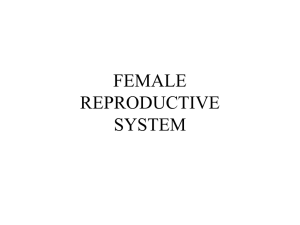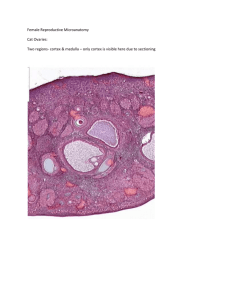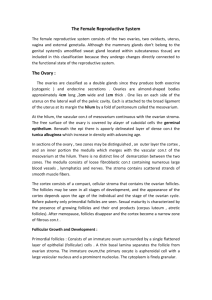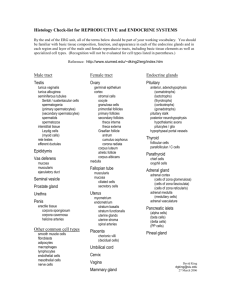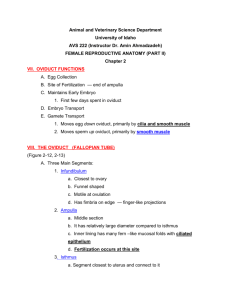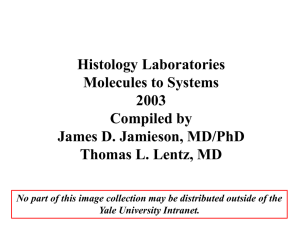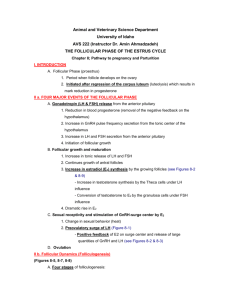Female Reproduction - PEER
advertisement
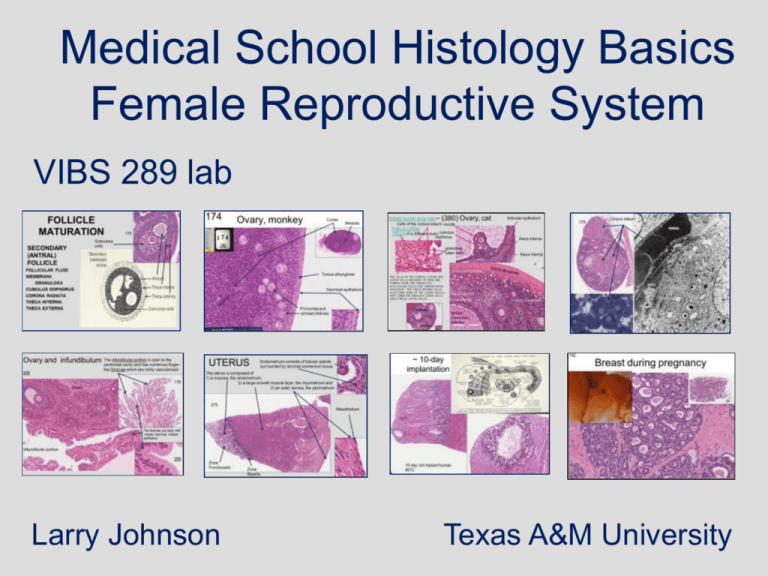
Medical School Histology Basics Female Reproductive System VIBS 289 lab Larry Johnson Texas A&M University OBJECTIVE To learn the structure of the ovary, fallopian tube, uterus, cervix, and vagina To learn how these organs contribute to the many functions of the female reproductive system To learn how hormones regulate and/or orchestrate the female reproductive processes Outline General structure of the ovary Follicular development Fallopian tube Uterus/Cervix/Vagina Hormonal orchestration Fertilization/ Pregnancy Lactation FEMALE REPRODUCTIVE SYSTEM Function The ovaries cyclically secrete steroid hormones and periodically release ova, the female gametes. Ova production Ova and sperm transportation Microenvironments for fertilization Implantation and fetal-placental growth Nourishment and support of offspring Postnatal repetition OVARY GENERAL STRUCTURE • • • • GERMINAL EPITHELIUM TUNICA ALBUGINEA MEDULLA CORTEX FUNCTIONAL OVERVIEW ORIGIN OF GERM CELLS 174 Ovary, monkey Cortex Medulla Tunica albunginea Germinal epithelium Primordial and primary follicles 280 Secondary follicle Ovary Primordial and Medulla Primary follicles Oocyte Follicular cells Tunica albunginea Cortex Germinal epithelium Theca folliculi. Granulosa cells of thestratum granulosum FOLLICLE MATURATION PRIMORDIAL FOLLICLES • • OOCYTE FOLLICULAR (GRANULOSA) CELLS 174 FOLLICLE MATURATION 174 175 Ova PRIMARY FOLLICLE • • • • ZONA PELLUCIDA STRATUM GRANULOSUM THECAL FOLLICULI CALL-EXNER BODIES FOLLICLE MATURATION SECONDARY (ANTRAL) FOLLICLE FOLLICULAR FLUID MEMBRANA GRANULOSA CUMULUS OOPHORUS CORONA RADIATA THECA INTERNA THECA EXTERNA Granulosa cells 175 FOLLICLES Graafian follicles. FOLLICLE MATURATION GRAAFIAN FOLLICLE Membrane granulosa 172 DEMO SLIDE BOX 194 – (380) Ovary, cat. follicular epithelium Cells of the corpus luteum oocyte THECA LUTEIN CELLS of a different ovary cumulus oophorus. theca interna granulosa lutein cells, theca externa primordial follicles THE CELLS OF THE CORPUS LUTEUM ARE LUTEIN CELLS AND MOST OF THEM ARE FORMED FROM THE GRANULOSA (FOLLICULAR) CELLS THAT REMAIN AFTER OVULATION. THE THECA INTERNA CELLS ALSO FORM SOME OF THE LUTEIN CELLS ( THEY FORM THE SMALLER LUTEIN CELLS, CALLE THECA LUTEIN CELLS) medulla cortex theca externa theca interna tertiary (vesicular) follicles Several primary follicles surface epithelium Ovary Oocytes, follicular cells, and surrounding connective tissue 172 EM 25: early primary follicle 1. Cytoplasm of primary oocyte 2. Zona pellucida 3. Follicular cell 268 ATRESIA OF FOLLICLES Slides 268 and 280 280 280 Death of the oocyte and collapse of the zona pellucida. (not shown) Separation and pyknosis of granulosa cells “Glassy membranes" OVULATION After OVULATION, the CORPUS LUTEUM DEVELOPS FROM REMAINS OF FOLLICULAR WALL AFTER OVULATION Granulosa lutein cells, secrete progesterone, the predominant postovulatory steroid. Ovary, corpus luteum 1. Granulosa lutein 2. Theca lutein 3. Central clot 170 268 Corpus luteum of ovary 170 Corpus luteum and corpus albicans of ovary Corpus albicans Corpus luteum Corpus luteum 175 282 173 Ovary - corpus albican Corpus albican HORMONES ORCHESTRATE THE PROCESS OOGENESIS - FORMATION AND DEVELOPMENT OF OVA MITOSIS (OOCYTOGENESIS) – OOGONIA – PRENATAL DEVELOPMENT (RUMINANTS, RODENT, SWINE, HUMAN) – POSTNATAL DEVELOPMENT (CARNIVORES) OOGENESIS - FORMATION AND DEVELOPMENT OF OVA MEIOSIS – OOCYTES EARLY DEVELOPMENT MATURATION ARREST (DICTYATE STEP OF MEIOTIC PROPHASE) LATER DEVELOPMENT SYNCHRONIZED WITH DEVELOPMENT AND MATURATION OF FOLLICLES DIVISION • FIRST MEIOTIC DIVISION – REDUCTION DIVISION – FIRST POLAR BODY • SECOND MEIOTIC DIVISION – EQUATIONAL DIVISION – SECOND POLAR BODY MEIOSIS Zygote MEIOSIS (ONLY IN SPERMATOGENESIS AND OOGENESIS) EXCHANGE OF GENETIC MATERIAL IN HOMOLOGOUS CHROMOSOMES (LEPTOTENE, ZYGOTENE, PACHYTENE, AND DIPLOTENE STEPS OF DEVELOPMENT) PRODUCES HAPLOID CONDITION OF GAMETES Female OOGENESIS) Primordial follicles birth 174 Female Primordial birth OOGENESIS) FALLOPIAN TUBE (OVIDUCT OR UTERINE TUBE) SEGMENTS • INFUNDIBULUM WITH FIMBRIAE • AMPULLA • ISTHMUS • INTRAMURAL SEGMENT Ovary and infundibulum 268 The infundibular portion is open to the peritoneal cavity and has numerous fingerlike fimbriae which are richly vascularized. 179 Ovary The fimbriae are lined with simple columnar ciliated epithelium Infundibular portion 268 Ampulla of oviduct Secretory cells Labyrinthine structure of the mucosal folds of the ampulla region Ciliated cells 472 472 Fimbriated end 179 Muscularis Contractions of these muscles are important for movement of the fertilized egg in the tube. PHASES OF THE MENSTRUAL CYCLE OVERVIEW MENSTRUAL PHASE: DAYS 1-4 PROLIFERATIVE PHASE – EARLY: DAYS 4-7 – LATE: DAYS 7-14 SECRETORY PHASE: – EARLY: DAYS 15-21 – LATE: DAYS 21-28 MENSTRUATION DECIDUAL REACTION UTERUS GENERAL STRUCTURE PERIMETRIUM MYOMETRIUM ENDOMETRIUM ZONA BASALIS ZONA FUNCTIONALIS SPIRAL ARTERIES GENERAL STRUCTURE PERIMETRIUM MYOMETRIUM ENDOMETRIUM ZONA BASALIS ZONA FUNCTIONALIS 177 UTERUS Endometrium consists of tubular glands surrounded by stromal connective tissue. The uterus is composed of 1) a mucosa, the endometrium, 2) a large smooth muscle layer, the myometrium and 3) an outer serosa, the perimetrium 275 Mesothelium Zona Functionalis Zona Basalis Myometrium Endometrium, UTERUS • 1. Zona Basalis: The moderately thin zone at the bottom of the endometrium that interdigitates with the myometrium. Here the stroma is very compact and cellular and surrounds the bases of the glands. This layer does not respond to hormones and provides the structures from which the entire endometrium is regenerated every month. --------------------------------------------------------------------• 2. Zona Functionalis: The large zone above the Zone Basalis to the surface. The stroma (connective tissue) surrounding the glands is more loosely arranged. This layer does respond to ovarian hormones and much of it is shed during menstruation and discharged from the vagina. ZONA FUNCTIONALIS The endometrium SPIRAL ARTERIES 177 The Menstrual Cycle: Using a 28-day cycle, with day one representing the first day of menses (bleeding) and day 14 the time of ovulation, the phases of the cycle are as follows: 1. Menstrual phase: Occupies the first four days during which the functional zone is shed in tissue fragments. 2. Phase of repair, or early proliferative phase: Days 4-7 3. Phase of rapid growth, or late proliferated phase: Days 7-14 4. Luteal, or secretory phase: Days 15-28, often divided into roughly equivalent early and late phases. 176 275 473 Early proliferative 274 Late Proliferative Early Secretory Late Secretory Very Late Secretory phase Spiral arteries became increasingly tortuous 181 Glands . The decidual reaction = stromal cells have become larger with more voluminous cytoplasm. HORMONES ORCHESTRATE THE PROCESS acrosome reacted intact OVIDUCT Uterus with about 10 day old fetus – only the placental membranes are shown Endometrium, Myometrium Perimetrium CERVIX VAGINA ENDOCERVIX – CERVICAL MUCUS EXTERNAL OS ECTOCERVIX VAGINA STRUCTURAL COMPONENTS EPITHELIUM CERVIX External os Smooth muscle 180 Ectocervix = 478 junction of the differing types of epithelia occurs at the external os Stratified squamous epithelium Endocervix (canal of the cervix) is covered by a simple columnar epithelium of mucous-secreting cells that lines deep crypts. VAGINA The tubular vagina has a thick wall consisting of a multilayered epithelium, lamina propria, muscularis and serosa. The vagina has no glands and lubrication comes from serum exudate during sexual activity Serosa. 480 178 Muscularis Lamina propria, Multilayered epithelium NOURISHMENT and PROTECTION of OFFSPRING Uterus, late secretory 1. Decidual cells 2. Spiral arteries EM 26; trophoblast, 20,000x 1. Nucleus 2. Microvilli 3. Tubular cristae hemochorial placenta = human placenta 273 hemochorial placenta A type of placenta having the maternal blood in direct contact with the chorionic trophoblast. 273 123 CONNECTIVE TISSUE CLASSIFICATION NOURISHMENT AND PROTECTION OF OFFSPRING 411 Nipple 410 Breast 482 Breast, pregnancy 482 Breast, pregnancy 182 Breast during pregnancy HORMONES ORCHESTRATE THE PROCESS In summary Questions Female Reproductive System 1.The female reproductive system produces ova, transports ova and sperm, provides a microenvironment for fertilization, implantation of the fetal-placenta growth, and provides nourishment and protection post-natally. To accomplish these functions in constant repetition, coordination of organs is paramount. Examples of this coordination include: a. ovarian hormonal orchestration of the endometrial cycle b. ovarian hormonal feedback to the hypothalamus c. ovarian and pituitary orchestration of mammary gland development and lactation d. a and b e. a, b, and c 2. Oogenesis differs from spermatogenesis in: a. gonadal hormones that regulate the function of accessory sex organs b. cyclic nature of function of the ducts attached to the gonad c. the temperature of gonad d. a and b e. a, b, and c 3. Features of the fallopian tube include: a. ciliated epithelium on its luminal surface b. divisions known as the infundibulum, ampulla, and isthmus c. lymph vessels to add rigidity to the numerous finger-like fimbriae d. a and b e. a, b, and c Many illustrations in these VIBS Histology YouTube videos were modified from the following books and sources: Many thanks to original sources! • • Bruce Alberts, et al. 1983. Molecular Biology of the Cell. Garland Publishing, Inc., New York, NY. Bruce Alberts, et al. 1994. Molecular Biology of the Cell. Garland Publishing, Inc., New York, NY. • William J. Banks, 1981. Applied Veterinary Histology. Williams and Wilkins, Los Angeles, CA. • Hans Elias, et al. 1978. Histology and Human Microanatomy. John Wiley and Sons, New York, NY. • • Don W. Fawcett. 1986. Bloom and Fawcett. A textbook of histology. W. B. Saunders Company, Philadelphia, PA. Don W. Fawcett. 1994. Bloom and Fawcett. A textbook of histology. Chapman and Hall, New York, NY. • Arthur W. Ham and David H. Cormack. 1979. Histology. J. S. Lippincott Company, Philadelphia, PA. • • Luis C. Junqueira, et al. 1983. Basic Histology. Lange Medical Publications, Los Altos, CA. L. Carlos Junqueira, et al. 1995. Basic Histology. Appleton and Lange, Norwalk, CT. • L.L. Langley, et al. 1974. Dynamic Anatomy and Physiology. McGraw-Hill Book Company, New York, NY. • W.W. Tuttle and Byron A. Schottelius. 1969. Textbook of Physiology. The C. V. Mosby Company, St. Louis, MO. • • Leon Weiss. 1977. Histology Cell and Tissue Biology. Elsevier Biomedical, New York, NY. Leon Weiss and Roy O. Greep. 1977. Histology. McGraw-Hill Book Company, New York, NY. • • • Nature (http://www.nature.com), Vol. 414:88,2001. Arthur C. Guyton,1971.Textbook of Medical Physiology W.B. Saunders company, Philadelphia, PA WW Tuttle and BA Schottelius 1969 Textbook of Physiology C.V. Mosby Co. • A.L. Mescher 2013 Junqueira’s Basis Histology text and atlas, 13th ed. McGraw The end of
